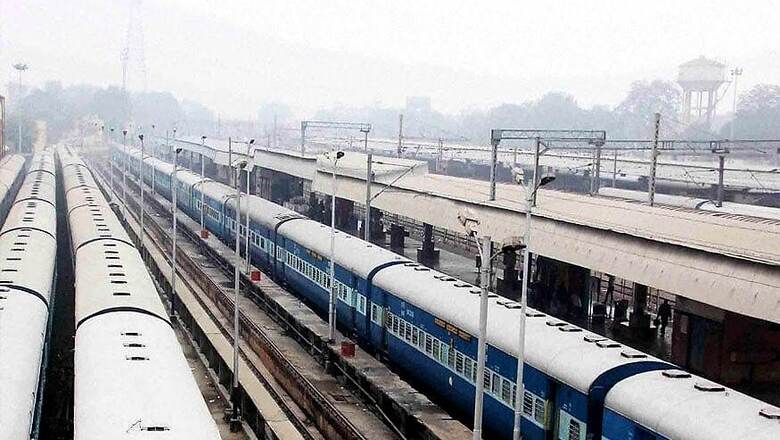
views
New Delhi: There will likely be no respite from crushing train delays this peak summer holiday season, as a choked network tries everything in the book to improve train punctuality. How delayed are India’s trains, its lifeline as far as passenger movement is concerned? Well, during mid-May, 59% of mail/express trains running in the East Central Railway Zone were delayed. This means only 4 in 10 such trains in the zone arrived on time.
More than a 100 mail/express trains are being delayed on average every day, by anywhere between 12-18 hours. The network wide punctuality of mail/express trains is just about 60%, which means almost one in three of these passenger trains is getting delayed. Compared to same period last year, train delays have become much worse since on-time arrival in mid-May last year for mail/express trains was 78%.
The Railways has no immediate solution in sight for chronic delays. It is banking on partial opening of the much-awaited dedicated freight corridors – two stretches of 400 km each – later this year, which will take some portion of the goods train traffic away from existing, choked rail tracks and ease up passenger traffic.
Railways officials say with a stiff track maintenance target set out for this fiscal, perhaps delays due to maintenance works will also reduce next fiscal. But there is no concrete solution in sight for immediate relief, with the network getting more burdened each day as traffic increases without commensurate increase in track length.
Sample this: the Indian Railways operates on 1,200 sections in all, of which 800 have already been saturated beyond capacity. Almost 400 of these sections are saturated up to 150% of capacity, another 400 are 100% used. The busiest rail route in the country is the Mughalsarai-Ghaziabad section, where capacity is 68 trains each way. But the Railways is already operating 50 passenger and 45 goods trains on this section, each way. Just six rail routes: Delhi-Mumbai, Mumbai-Chennai, Chennai-Kolkata, Kolkata-Delhi, Delhi-Chennai and Kolkata-Mumbai account for almost 60% of the Railways’ total traffic but use only 16% of route kilometres.
Adding to the capacity woes is the Railways’ new resolve on track maintenance to improve safety. After deadly accidents last year and the recent one on an unmanned level crossing in UP where more than a dozen children perished, it has been setting up stiff track renewal targets as well as targets for closing such unmanned crossings.
Remember, track maintenance and conversion of unmanned level crossings into manned crossings mandatorily needs suspension of operations for long periods of time each day for a section of the rail track. This, of course, delays the trains further.
Member (Traffic) of the Railway Board, Mohammad Jamshed, says the availability of a portion of the dedicated freight corridor by November this year and the achievement of a stiff track renewal target this fiscal may improve train delays in the coming months. The track renewal target for 2017-18 is about 5,000 km and if it is achieved, 70% of overdue maintenance works would have been completed and trains speeded up.
How far does maintenance work delay trains? Block hours, which refers to the time when no train movement is allowed on a section of the track to complete maintenance, jumped by almost by a fifth last fiscal and the target for maintenance remains at this level even for 2018-19. Speed restrictions also more than doubled to 4,000 locations in 2017-18 compared to the previous fiscal and are targeted at the same level in 2018-19 too.
Since 2014-15, the Railways has grappled with deadly accidents and has been blamed for lax maintenance standards besides other lapses for these mishaps. Stung by this incessant criticism, the Modi government shunted out Suresh Prabhu from the Railways Ministry in September last year, bringing in current incumbent Piyush Goyal.
Goyal has been insistent on enhancing all maintenance and safety related works, leading to the present situation where delays are plaguing the network but ministry officials are helpless to tackle these in the face of increased maintenance activities.
Meanwhile, from data given in the Lok Sabha during the Budget Session, one gets an idea of how delays are plaguing not just the mail/express passenger trains but also the premium ones like Rajdhanis and Shatabdis.
This reply shows how every third Rajdhani and every third Duronto was delayed between April 1, 2017 and March 10, 2018. Every sixth Shatabdi and almost every fourth mail/express train was delayed too.
In fact, 451 mail/express trains were delayed every day during this period – as explained earlier, this number has jumped significantly to over 600 a day now. These significant delays were reported even when trains arriving 15 minutes after their scheduled time were not included in the list.
Railway officials have indicated that there needs to be a “substantial” reduction in maintenance targets for train operations to normalise and become more punctual but this may not be what minister Goyal has in mind. So it is unlikely that India's trains will run on time just yet.
(The author is a senior journalist. Views are personal)




















Comments
0 comment